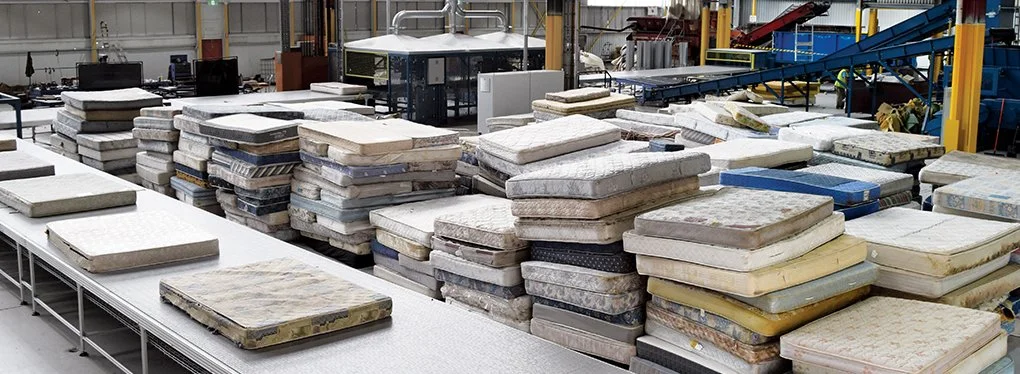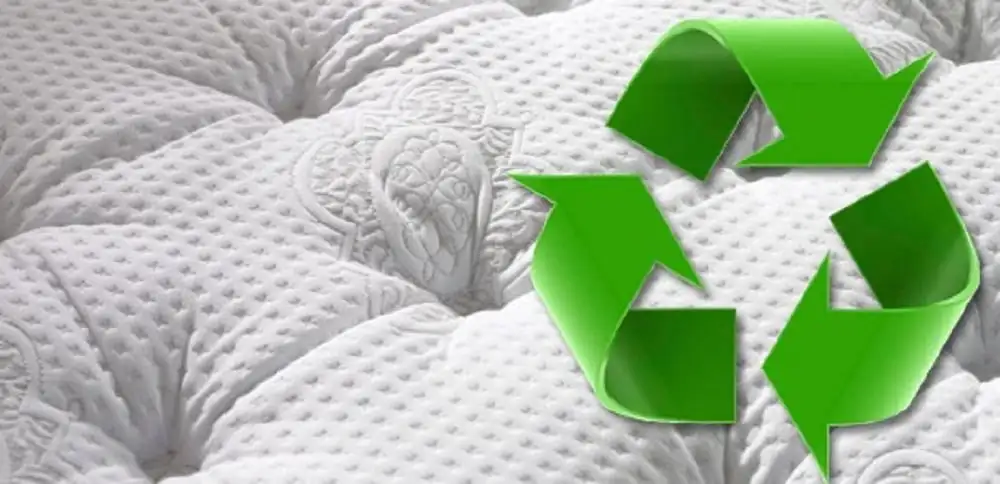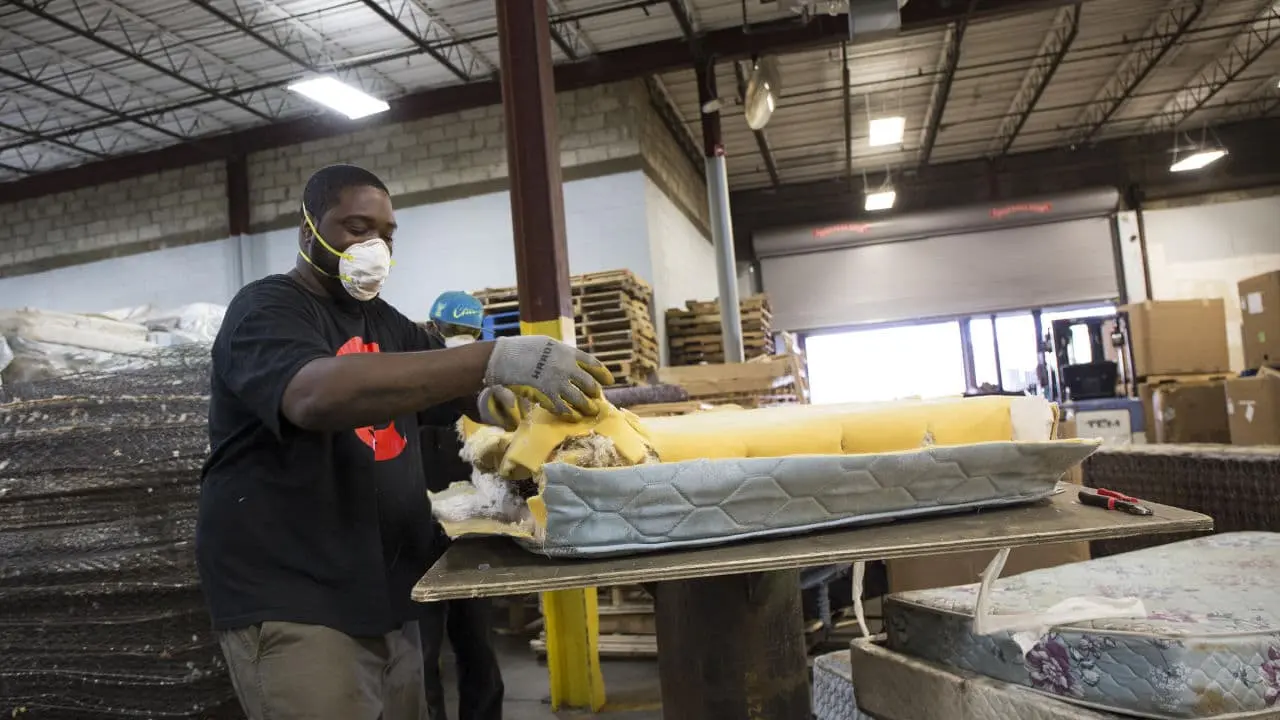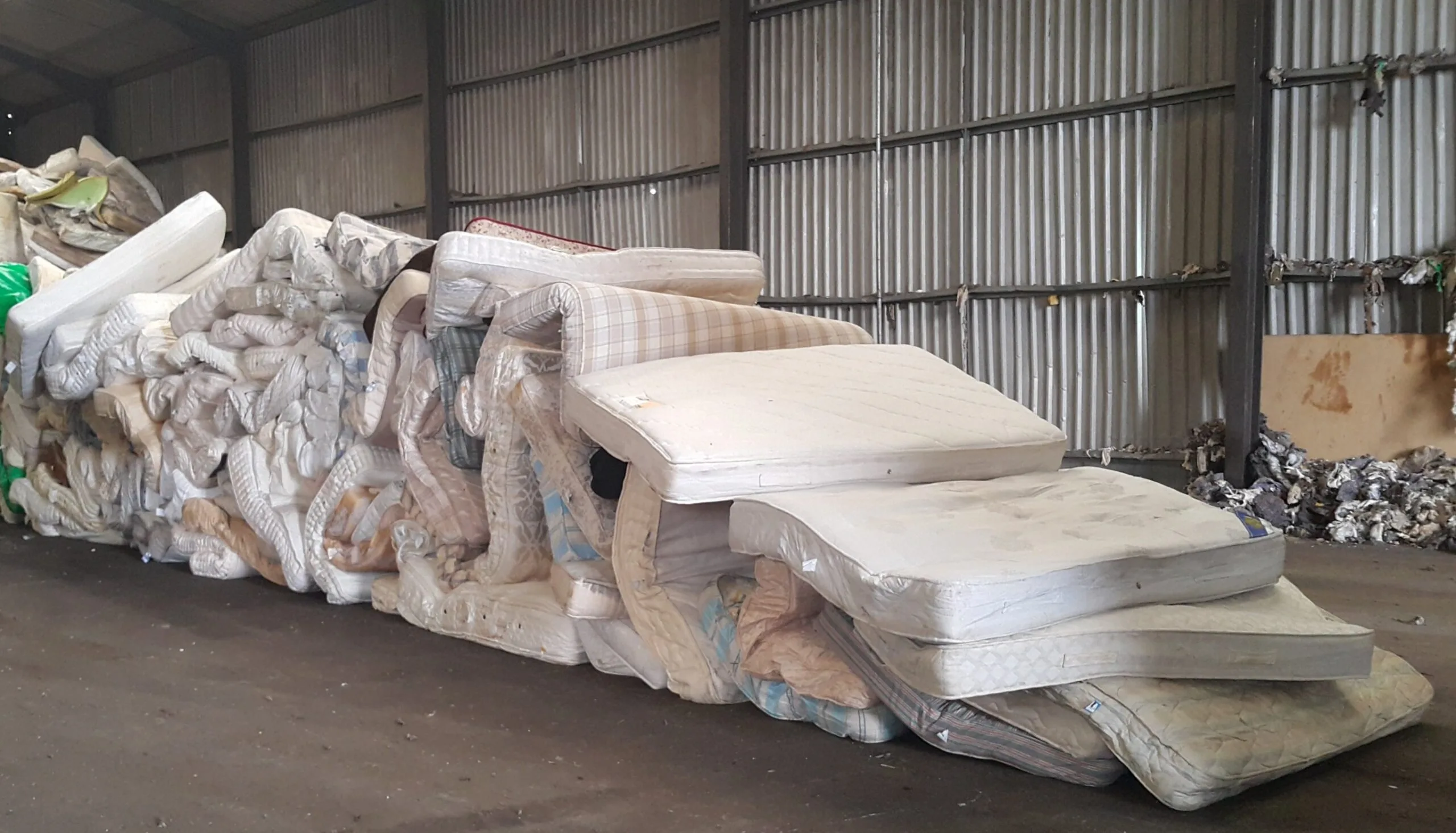Mattress recycling is an important aspect of waste management and environmental sustainability. With millions of mattresses being discarded each year, proper disposal and recycling techniques are crucial to minimize the impact on the environment.
Mattresses are primarily composed of materials such as foam, fabric, metal springs, and wood, all of which can be recycled and repurposed.
In this article, we will go through the benefits, the process, and the reasons why you should consider recycling your older mattress.
What is Mattress Recycling?
The recycling process involves dismantling the mattress and separating its components for recycling. The foam can be shredded for carpet padding or furniture stuffing, fabric and textiles can be repurposed into new materials, metal springs can be melted down for new products, and wood frames can be recycled for various purposes.
Recycling mattresses helps reduce landfill waste and conserves natural resources by repurposing materials, contributing to a more sustainable future. Many communities and organizations have implemented mattress recycling programs, including dedicated collection centers and specialized recycling companies.
Mattress recycling is important for responsible waste management and environmental preservation.
Why Recycling Mattresses Matters
Environmental benefits
- Reducing Landfill Wastes: Mattress recycling plays a significant role in reducing the strain on landfills. Mattresses are bulky and take up considerable space in landfills. By recycling them, we can free up valuable landfill space for other waste.
- Resource Conservation: Recycling mattresses helps to repurpose valuable materials such as foam, fabric, metal springs, and wood. These materials can be used in the production of new products, reducing the demand for virgin resources.
- Lower Carbon Footprint: Mattress recycling leads to a lower carbon footprint by reducing the energy and emissions associated with manufacturing new materials. For example, by recycling metal springs from mattresses, we can save energy and raw materials that would have been used in the production of new metal products. This contributes to a more sustainable and eco-friendly approach to resource utilization.
Economic Benefits
- Job Creation: Mattress recycling creates job opportunities in the recycling industry, from collection and transportation to processing and manufacturing. For example, specialized mattress recycling companies employ workers to dismantle, sort, and process the materials, contributing to local economies and employment opportunities.
- Resource Efficiency: Mattress recycling promotes resource efficiency by extracting value from materials that would otherwise be discarded. For instance, the wood frames from mattresses can be recycled and used for various purposes.
- Potential Cost Savings: Mattress recycling can lead to potential cost savings for consumers and municipalities. By diverting mattresses from landfills and utilizing their materials for new products, the overall waste management costs can be reduced.
Steps Behind Mattress Recycling Facilities

1) Drop-Off or Collection
At mattress recycling facilities, the process typically begins with the drop-off or collection of old mattresses. Individuals or organizations can bring their discarded mattresses to these facilities for recycling purposes.
Some cities have dedicated collection centers where residents can drop off their old mattresses, while some companies offer pickup services to ensure proper disposal.
2) Sorting and deconstruction
Once the mattresses are collected, they undergo a meticulous sorting and deconstruction process at the recycling facilities.
Skilled workers carefully sort through the mattresses to separate materials such as foam, metal springs, fabric, and wood frames. More details about the specific materials are explained below.
Specialized techniques are used to deconstruct the mattresses into their components, ensuring that each material is extracted efficiently and effectively. This sorting and deconstruction process is crucial in preparing the materials for the next recycling phase.
3) Material Processing
After the materials are extracted from the mattresses, they undergo various methods of processing at the recycling facilities.
The foam is shredded and processed to create new foam products, such as carpet padding or furniture stuffing. Metal springs are melted down to be reused in the production of new metal products, contributing to the conservation of resources.
4) Repurposing
The concept of repurposing plays a significant role in mattress recycling facilities. The recycled materials, including foam, metal, and fabric, are repurposed in innovative ways to create new products or applications.
This innovative approach to repurposing the materials demonstrates the commitment of mattress recycling facilities to minimize waste and contribute to a more sustainable future by giving new life to recycled materials.
5) Fees and Regulations
In terms of fees or regulations, it's important to be aware of any potential costs associated with mattress recycling. While some facilities may offer free drop-off or collection services for mattresses, others may charge a fee for the recycling process.
Additionally, certain regulations or restrictions may apply, such as limitations on the types of mattresses accepted or specific drop-off hours. Understanding these aspects can help you plan for the recycling process accordingly and avoid any unexpected challenges.
How Mattress Materials are Recycled

A mattress is made of various materials, including foam, fabric, metal springs, and wood. Each of these materials is recyclable and can be repurposed to minimize environmental impact.
When a mattress is recycled, it undergoes a process where its different components are separated and processed for recycling.
Metal Components
- Separation: Mattress metal recycling starts with separating springs, frames, and coils. Manual and mechanical processes, like shredders and shears, dismantle the mattress, removing fabric and foam to expose the metal. Diverse mattress designs and fasteners can make separation tricky, but specialized equipment helps extract the metal efficiently.
- Processing: Separated metal components undergo a multi-step transformation for recycling. First, a cleaning process removes contaminants like oil, paint, and debris using high-pressure water jets, scraping, or chemical baths, depending on the material. Next, meticulous sorting by automated machinery and manual inspection categorizes the metals based on composition and size, ensuring efficient processing. Finally, some components might be compacted, crushed, or shredded.
- Repurposing: The recycled metal components from mattresses find various applications across industries, contributing to both environmental and economic benefits. By using recycled metal components, industries reduce their reliance on virgin resources, leading to a decrease in energy consumption and greenhouse gas emissions associated with metal production.
Natural and Synthetic Fibers
Separation: Another step in recycling mattress materials involves separating the components into their respective categories, notably natural fibers (e.g., cotton and wool) and synthetic fibers (e.g., polyester). This separation process typically utilizes mechanical and manual techniques to carefully extract the different materials.
Processing: After the separation of natural and synthetic fibers, each type of fiber undergoes specific processing procedures to prepare them for recycling.
- Natural Fibers (Cotton and Wool): Natural fibers, such as cotton and wool, are subjected to cleaning processes to remove contaminants like dirt, oils, and residual chemicals. This cleaning stage involves washing and scouring to enhance the purity and quality of the fibers. Once cleaned and aligned, the fibers are ready for shredding, where they are broken down into smaller, uniform pieces suitable for further processing.
- Synthetic Fibers (Polyester): Synthetic fibers, like polyester, undergo a different set of processing procedures. Initially, the polyester fibers are cleaned to eliminate any surface impurities and contaminants. This cleaning process involves washing and chemical treatments to enhance the purity of the fibers. Following cleaning, the polyester fibers are then shredded into fine, uniform particles to facilitate their integration into recycled products.
Repurposing: The recycled mattress materials, comprising Natural Fibers (Cotton and Wool) and Synthetic Fibers (Polyester), find applications across various industries and products.
- Natural Fiber Repurposing: Recycled Cotton fibers are commonly utilized in the production of sustainable textiles, including apparel, home furnishings, and industrial fabrics. The repurposing of recycled Wool fibers extends to insulation materials, felted products, and eco-friendly yarns for weaving and knitting.
- Synthetic Fiber Repurposing: Repurposing of recycled Polyester fibers is prevalent in the manufacturing of diverse products such as carpets, upholstery, and non-woven materials.
Wood

- Separation: The initial step of separating wood from other mattress materials during the recycling process requires careful sorting and segregation. The mattresses are dismantled, and the wood frames and foundations are separated from other components such as foam, fabric, and metal springs. To ensure that the wood is free from contaminants or non-wood materials, thorough inspection and sorting are conducted, removing any metal fasteners, adhesives, or fabric remnants that may be attached to the wood frames.
- Processing: Once the wood frames are separated, they undergo a processing stage to prepare them for repurposing. The wood is typically processed using machinery such as wood shredders or chippers, which break down the frames into smaller pieces or chips. This step is crucial for transforming the bulky wood frames into manageable and uniform pieces that can be utilized in various applications.
- Repurposing: Recycled mattress wood offers a variety of applications across industries. In furniture manufacturing, it contributes to sustainable design by creating new pieces. Construction utilizes the wood for structural or decorative purposes, reducing reliance on virgin timber. Landscaping applications include using recycled wood for outdoor structures, garden beds, or pathways. Additionally, this wood can be processed into biomass fuel, contributing to renewable energy generation.
What can you do with an old mattress?
Check Warranty
Checking the warranty is an important step, as some mattresses come with warranties that include disposal or recycling provisions.
Manufacturers or retailers may offer end-of-life programs where they take back old mattresses for recycling or responsible disposal, often as part of a product replacement or upgrade.
Reupholstery
Another option to consider is reupholstery, particularly for mattresses with quality materials and a durable structure. Reupholstering a mattress involves replacing the fabric and padding, which can extend its lifespan and provide a more sustainable alternative to discarding it.
Donation
For those looking to contribute to charitable causes, donating the mattress to local shelters, charities, or organizations that accept used bedding can be a meaningful option. Many non-profit organizations welcome gently used mattresses to support individuals and families in need.
Sell Online
Selling the mattress online through platforms like marketplace websites or classified ads can also be a viable option for those looking to recoup some of the initial investment. Properly disclosing the mattress's condition and providing accurate details can help potential buyers make informed decisions.
FAQs
If a mattress has bed bugs, can it still be recycled?
A mattress that has bed bugs is generally not suitable for recycling due to the potential risk of spreading infestations. Bed bugs can be difficult to eradicate, and the presence of bed bugs in a mattress poses a health hazard and contamination risk. However, using glue traps or ozone may help get rid of them.
Can box springs be recycled?
Yes, box springs can be recycled. Similar to mattresses, box springs contain recyclable materials such as wood, metal springs, and fabric. Recycling facilities can dismantle box springs and process the individual components for recycling.
Can an air mattress be recycled?
Air mattresses can be recycled, but the process may vary depending on the specific materials used in their construction. Many air mattresses are made of PVC or vinyl, which can be recycled into new products. However, it's important to check with local recycling facilities or specialized mattress recycling companies to determine the appropriate recycling methods for air mattresses.
What happens to the materials that can’t be recycled when recycling a mattress?
When a mattress is recycled, the materials that cannot be recycled are typically disposed of or processed separately.
Is there a second-hand market for mattresses?
Yes, there is a second-hand market for mattresses, particularly those in good condition. Many individuals and organizations engage in the resale of gently used mattresses through platforms like consignment stores, online marketplaces, and charitable donation programs.
Conclusion
Mattress recycling is a tedious process that has many approaches. However, it has many benefits, and by implementing and supporting mattress recycling programs, individuals, communities, and organizations can contribute to a more sustainable and responsible approach to waste management and resource utilization.
Jessica H.
Jessica is a reviewer, writer, and sleep enthusiast at Sleepiverse. Jessica graduated with her master's degree in Nursing research and education. She is a registered nurse and currently works in the Intensive Care Unit. Since becoming a nurse, Jessica has worked the night shift, which means a disrupted sleep schedule. Knowing she needed to function at her best while caring for patients at night, she spent a lot of time researching how to sleep well with a difficult schedule.


